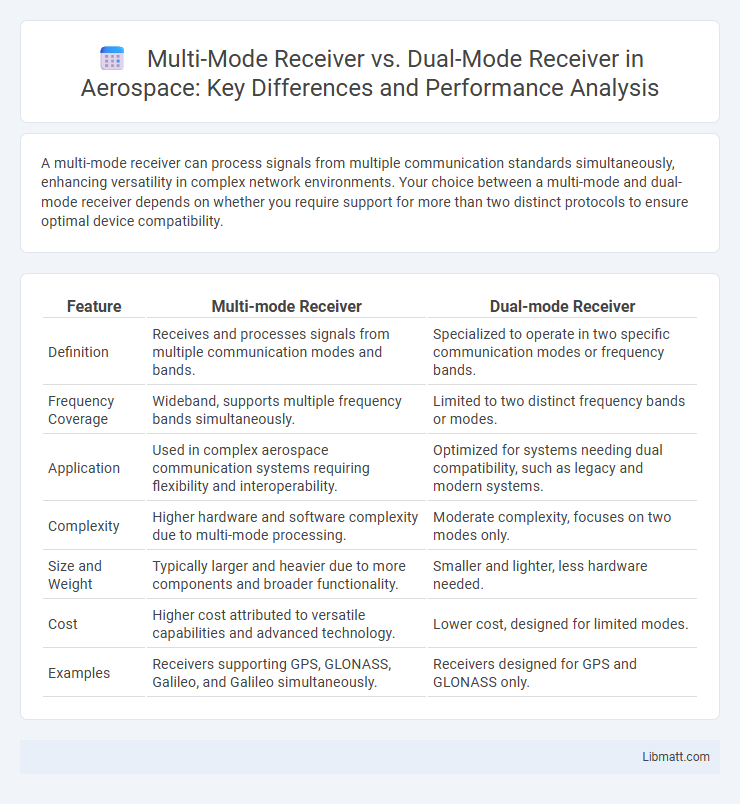A multi-mode receiver can process signals from multiple communication standards simultaneously, enhancing versatility in complex network environments. Your choice between a multi-mode and dual-mode receiver depends on whether you require support for more than two distinct protocols to ensure optimal device compatibility.
Table of Comparison
| Feature | Multi-mode Receiver | Dual-mode Receiver |
|---|---|---|
| Definition | Receives and processes signals from multiple communication modes and bands. | Specialized to operate in two specific communication modes or frequency bands. |
| Frequency Coverage | Wideband, supports multiple frequency bands simultaneously. | Limited to two distinct frequency bands or modes. |
| Application | Used in complex aerospace communication systems requiring flexibility and interoperability. | Optimized for systems needing dual compatibility, such as legacy and modern systems. |
| Complexity | Higher hardware and software complexity due to multi-mode processing. | Moderate complexity, focuses on two modes only. |
| Size and Weight | Typically larger and heavier due to more components and broader functionality. | Smaller and lighter, less hardware needed. |
| Cost | Higher cost attributed to versatile capabilities and advanced technology. | Lower cost, designed for limited modes. |
| Examples | Receivers supporting GPS, GLONASS, Galileo, and Galileo simultaneously. | Receivers designed for GPS and GLONASS only. |
Introduction to Multi-Mode and Dual-Mode Receivers
Multi-mode receivers support multiple communication standards such as GSM, CDMA, and LTE within a single device, enabling seamless connectivity across different networks. Dual-mode receivers, in contrast, typically handle two specific types of network technologies, like GSM and CDMA, providing focused compatibility for targeted applications. These receivers play a critical role in mobile devices by ensuring reliable signal reception and handoffs between diverse wireless systems.
Key Definitions: Multi-Mode vs Dual-Mode Receiver
Multi-mode receivers are designed to support multiple communication standards and frequency bands, allowing seamless operation across various wireless networks such as GSM, LTE, and 5G. Dual-mode receivers specifically handle two distinct technologies or frequency bands, often enabling interoperability between legacy and modern systems like 3G and LTE. Understanding these key definitions helps you choose the right receiver type for versatile connectivity and enhanced network compatibility.
Core Technologies Behind Each Receiver Type
Multi-mode receivers integrate multiple communication standards such as GSM, CDMA, LTE, and 5G NR using software-defined radio (SDR) and advanced digital signal processing (DSP) to dynamically switch and decode signals, enabling versatile connectivity. Dual-mode receivers typically combine two specific technologies, often GSM and CDMA, relying on dedicated hardware modules and dual-band antennas for efficient switching between modes. While multi-mode architectures emphasize flexibility through programmable RF front-ends and baseband processors, dual-mode designs prioritize optimized hardware integration to manage limited spectrum bands and reduce power consumption.
Functional Differences: Multi-Mode vs Dual-Mode
Multi-mode receivers support multiple communication standards simultaneously, allowing seamless switching between different networks like LTE, 5G, and Wi-Fi, enhancing device compatibility and connectivity. Dual-mode receivers, in contrast, are designed to handle only two specific communication standards, such as GSM and CDMA, limiting their flexibility but often improving performance in those particular networks. Understanding these functional differences can help you choose the right receiver type based on your device's network requirements and intended usage scenarios.
Advantages of Multi-Mode Receivers
Multi-mode receivers offer significant advantages by supporting multiple communication standards such as LTE, 5G NR, and Wi-Fi, enhancing device versatility and global connectivity. These receivers enable seamless switching between different signal types, which improves connection reliability and user experience in diverse network environments. Furthermore, multi-mode receivers reduce hardware complexity and overall system cost by integrating various protocols into a single chipset.
Benefits of Dual-Mode Receivers
Dual-mode receivers offer enhanced connectivity by seamlessly supporting two distinct communication standards, improving device compatibility across different networks. They provide greater flexibility for users by enabling automatic switching between modes, which ensures reliable signal reception and extended coverage. This dual functionality reduces hardware redundancy and power consumption compared to multi-mode receivers, which handle more modes but often with increased complexity and cost.
Application Scenarios for Each Receiver Type
Multi-mode receivers are ideal for complex communication systems requiring seamless switching between multiple wireless standards, such as smartphones operating on 4G, 5G, and Wi-Fi networks. Dual-mode receivers typically serve devices needing compatibility with two specific communication protocols, like Bluetooth and Wi-Fi in wireless headsets or IoT gadgets. Your choice depends on whether your application demands broad multi-standard support or focused dual-protocol functionality.
Performance Comparison: Multi-Mode vs Dual-Mode
Multi-mode receivers support multiple communication standards simultaneously, offering higher versatility and better connectivity performance across various networks compared to dual-mode receivers, which handle only two specific standards. Multi-mode receivers typically deliver improved signal quality, faster data rates, and broader coverage, enhancing your device's ability to maintain reliable communication in diverse environments. Dual-mode receivers may suffice for simpler applications but fall short in seamless performance and adaptability compared to the comprehensive capabilities of multi-mode technology.
Cost and Integration Considerations
Multi-mode receivers typically offer greater integration of multiple communication standards, reducing the need for separate hardware components and lowering overall system complexity. Dual-mode receivers, while supporting two specific modes, may incur higher costs due to specialized components required for each mode's compatibility and switching. Your choice between multi-mode and dual-mode receivers should weigh the trade-offs between upfront cost savings and the ease of integration within your existing device architecture.
Future Trends in Receiver Technology
Multi-mode receivers support a broader range of communication standards, enhancing connectivity in evolving network environments, while dual-mode receivers typically handle two specific standards for targeted applications. Future trends indicate a shift towards more integrated, software-defined architectures enabling seamless updates and adaptability to emerging global technologies like 5G, Wi-Fi 7, and beyond. Enhanced receiver sensitivity and energy efficiency will play critical roles in meeting the demands of ultra-reliable, low-latency communication for IoT and next-generation mobile networks.
Multi-mode receiver vs Dual-mode receiver Infographic

 libmatt.com
libmatt.com